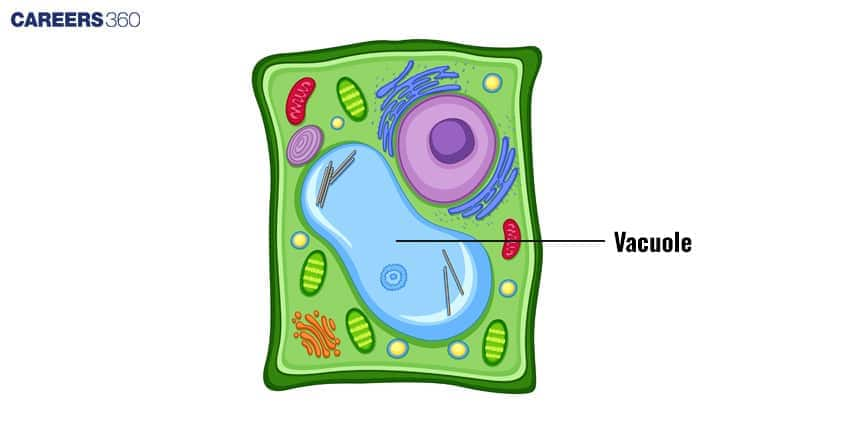Vacuoles: Definition, Types, Examples, Diagram, Functions
Vacuoles are membrane-bound organelles surrounded by a tonoplast and filled with cell sap. They help in storage of nutrients and wastes, maintaining turgor pressure, detoxification, and homeostasis. In plants, a large central vacuole provides rigidity and growth, while in animal cells, vacuoles are smaller and specialized. It is a key Class 11/12 and NEET Biology concept from Cell: The Unit of Life.
This Story also Contains
- What is a Vacuole?
- Structure of Vacuole
- Types of Vacuoles
- Functions of Vacuole
- Formation and Life Cycle of Vacuoles
- Vacuoles and Cellular Homeostasis
- Importance in Biotechnology and Research
- Vacuole NEET MCQs (With Answers & Explanations)
- Recommended video on Vacuoles

What is a Vacuole?
Vacuoles are organelles that have several cellular functions. They can store food or nutrients to keep a cell alive. They also store all the waste products and prevent the whole cell from contamination. The vacuoles of the plant cells are bigger than those of the vacuole in animal cells. More than 80% of the volume of the cell is occupied by plant vacuoles. They are one or numerous of them in number.
Vacuoles are considered an important part of cellular homeostasis and general cell function. Therefore, its knowledge is fundamental for students to gain a foundation in cell biology that will assist them in understanding more complex, higher-level cellular processes and structures.
Structure of Vacuole
The structure of vacuoles is surrounded by a membrane called the tonoplast and its internal contents are separated from the cytoplasm of the cell. The movement of molecules into and out of the vacuole is regulated by this membrane. This further controls the cell sap composition.
The cell sap, or the internal content of the vacuoles, consists of the ions, sugars, pigments and other water molecules. The functions performed include storing nutrients and waste materials and maintaining turgor pressure.

Types of Vacuoles
The types of vacuoles are discussed below:
Central Vacuoles
Plant cells have a large central vacuole, which occupy approximately 30 per cent of the cell volume. This central vacuole is important in the turgor pressure, storage of water, and nutrients, and the regulation of the pH of the cell's interior environment. It also allows for cell enlargement, thereby giving the plant structural support.
Contractile Vacuoles
Some protists, such as protozoa, have contractile vacuoles. It prevents flooding of the cell with water and prevents it from bursting. The vacuole does this by rhythmically contracting to pump excess water from the cell.
Food vacuoles
Food vacuoles develop during the process of phagocytosis, in organisms such as amoeba. A foreign organism or food particles that are engulfed become enclosed in the food vacuole. Digestive enzymes are then secreted into the food vacuole to break down the ingested material, after which it is absorbed by the organism for energy and growth.
Functions of Vacuole
The various functions of vacuoles are:
Vacuoles function as storage compartments for nutrients, ions, sugar pigments and waste products.
Vacuoles also store some substances that are potentially damaging to the cell, such as toxins or by-products of metabolism, keeping them away from the rest of the cell.
These play a significant role in the development of a plant cell by helping to control cell expansion, enlargement, and differentiation.
They also contain enzymes and an acidic environment that provides for the digestion of macromolecules and cellular waste products.
The vacuole takes the substances through a process called endocytosis, after which the contents are digested and then excreted through exocytosis. The contents are stored within the cells and separated from the cytosol.
Formation and Life Cycle of Vacuoles
Vacuoles are produced in a cell through various mechanisms, but the most important one is the fusion of small vesicles formed from the Golgi apparatus and the endoplasmic reticulum. The vacuole lifecycle involves strongly controlled membrane dynamics, protein traffic, and organelle interaction, enabling the vacuole to play a role in maintaining cell homeostasis and growth.
Vacuoles and Cellular Homeostasis
They serve in the maintenance of cellular homeostasis by regulating the pH and detoxification processes. They regulate the pH by actively pumping ions into and out of the vacuole. Thereby adjusting acidity and alkalinity to maintain homeostasis in the cell's internal environment. This is very important in enabling the cell to maintain optimum conditions for enzymatic activities along with other biochemical processes. Also, they serve as stores for harmful substances, sequestering dangerous molecules and preventing their detrimental effects on the cell.
Importance in Biotechnology and Research
Vacuoles are quite prominent in genetic engineering research and biotechnology, concerning the manipulation of genes and the study of their functions in different organisms. Therefore, they can be targets of gene insertion or alteration for product production or a gene function study.
Moreover, the continued research in vacuole function in a multitude of organisms yields very useful information on cellular function, disease processes, and biotechnological potential that moves the edge of knowledge along a line from agriculture to medicine.
Vacuole NEET MCQs (With Answers & Explanations)
Important topics for NEET exams:
Vacuoles in Plants
Types of Vacuoles
Practice Questions for NEET
Q1. Which of the following statement is not correct for vacuoles
Contractile vacuoles help in excretion
Tonoplast facilitates the transport of ions against the concentration gradient into the cytoplasm
Food vacuoles are formed by engulfing the food particles
Sap vacuole is bound by single membrane
Correct answer: 2) Tonoplast facilitates the transport of ions against the concentration gradient into the cytoplasm
Explanation:
The tonoplast is the membrane surrounding the vacuole. The vacuole helps in maintaining cell volume and cell turgor; the regulation of cytoplasmic ions and pH. The tonoplast helps in the transport of ions and minerals against the concentration gradient into the vacuole utilizing energy in the form of ATP. Therefore statement 2 is wrong.
Hence, the correct answer is option 2) Tonoplast facilitates the transport of ions against the concentration gradient into the cytoplasm
Q2. When a number of primary lysosomes fuse to clear the worn out organelles, ____ are formed
Primary lysosomes
Secondary lysosomes
Autophagic vacuoles
Residual bodies
Correct answer: 3) Autophagic vacuoles
Explanation:
When some primary lysosomes fuse to clear the worn-out organelles, autophagic vacuoles are formed. When some primary lysosomes fuse to clear the worn-out organelles, autophagic vacuoles are formed. These vacuoles contain the damaged or old organelles that are targeted for degradation. The lysosomal enzymes inside the autophagic vacuole break down the organelle components into basic molecules, which can then be recycled by the cell. Autophagy is a vital cellular process for maintaining homeostasis, as it removes dysfunctional organelles and protects the cell from stress.
Hence, the correct answer is option 3) Autophagic vacuoles
Q3. Inclusion bodies of blue-green, purple, and green photosynthetic bacteria are:
Gas vacuoles
Centrioles
Microtubules
Contractiles vacuoles
Correct answer: 1) Gas vacuoles
Explanation:
Green, purple, and blue-green (cyanobacteria) photosynthetic bacteria all have inclusion bodies called gas vacuoles.
These gas-filled networks help the bacteria control their buoyancy, which allows them to position themselves in the water column in the most suitable potential way to absorb light during photosynthesis.
Hence, the correct answer is option 1) Gas Vacuoles.
Also Read:
Recommended video on Vacuoles
Frequently Asked Questions (FAQs)
In plant cells, vacuoles maintain turgor pressure, nutrient storage as well as the regulation of pH, and help in cellular growth and development.
Vacuoles are bigger in plant cells when compared to animal cells for the maintenance of turgor pressure.
Vacuoles help maintain turgor pressure through the acquisition of water and solutes that produce osmotic pressure. This maintains rigidity and uprightness in standing cells.
The main difference in vacuoles between plant cells and animal cells is based on size and function. Plant cells mostly contain a single large central vacuole, occupying most of the cell's volume, while animal cells contain much smaller vacuoles that may be very different in function.
Vacuoles help the organism in storage and structural support, carry out the mechanisms of osmoregulatory function, waste-material management, and several physiological processes.